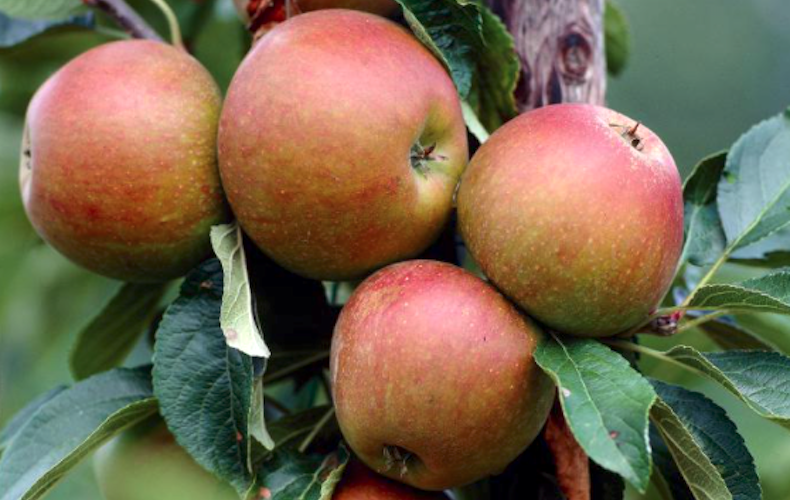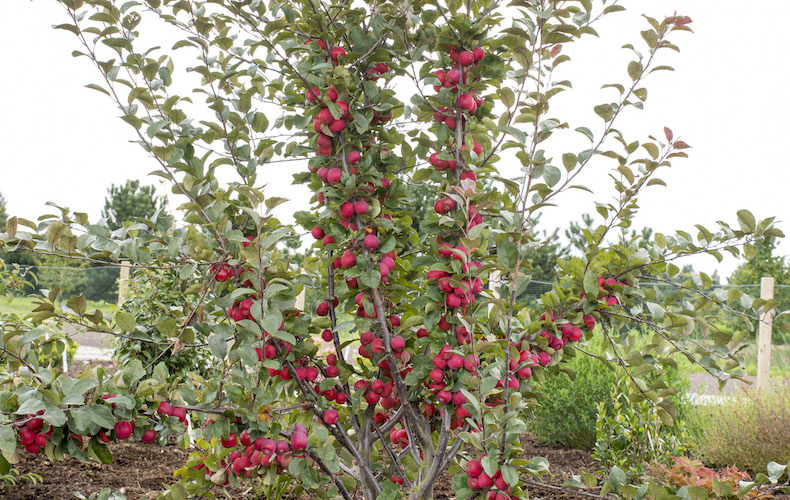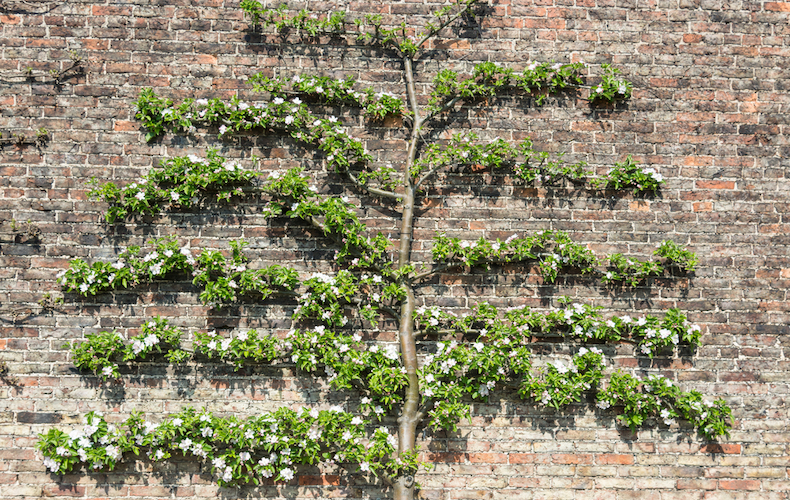
How to prune apple trees
Apple trees need regular pruning to stay healthy and produce lots of fruit. Whether you grow your apple tree as a standard, or train it against a wall as a cordon, espalier or fan, correct pruning is vital to success. Here, horticultural expert Mandy Bradshaw explains exactly how and when to prune your apple trees.
Browse our full range of apple trees to find the best variety for your garden.
When to prune apple trees

Apple 'Cox's Orange Pippin' has an aromatic flavour and crisp, juicy texture
Image: Visions BV, Netherlands
Standard apple trees are mainly pruned in winter, between November and early March when the plant is dormant. Winter pruning stimulates root growth.
Trained apple trees should be pruned in summer, with just a tidy up during winter if required. Mid- to late-August is ideal.
Most apple trees produce fruit on spurs – short shoots that sprout on older wood. However, a few varieties, known as tip-bearers, fruit at the end of long shoots that were produced the year before. Identify which type of apple tree you have to avoid accidentally removing all the shoots that will produce next year’s crop.
How to prune standard apple trees

Aim for an open goblet shape that allows plenty of sunlight to reach and ripen the fruit
Image: Apple 'Appletini' from Thompson & Morgan
To prune your apple tree you’ll need a good set of steps, a pruning saw and sharp secateurs. It’s important to make clean cuts that will reduce the risk of introducing disease.
For standard apple trees you should aim to create an open, goblet shape that allows the maximum amount of light down into the tree and good air circulation.
- Start by removing dead, diseased or weak growth and any branches that are crossing.
- On spur-bearing trees, reduce the length of main branches by about a third.
- Cut to a good, outward-facing bud, making a slanted cut down and away from the bud to prevent rain pooling on it.
- Keep checking the tree’s overall shape before you make any more cuts.
- Side shoots, known as laterals, should be left over winter to produce fruit buds.
- Do remove any growth that is heading towards the centre of the tree, reducing air and light.
- On well established trees, thin out any congested fruit spurs. Start with those on the underside of branches as fruit there will struggle to ripen. Shorten others to leave the strongest, allowing space for developing fruit.
- On tip-bearing trees, stop branches getting too long by cutting back some of the older stems to a younger shoot.
How to prune trained apple trees

Remove any unwanted vertical growth in summer
Image: Andrew Fletcher/Shutterstock
Apples grown as cordon, espalier or fans should be pruned from mid-August. The aim is to maintain the desired shape and allow as much sun as possible to ripen the fruit. However, once the trees are mature, you may need to thin any congested spurs over the winter.
- Cut back new shoots more than 20cm long to three leaves above the basal leaves.
- Reduce any new shoots from existing side shoots to one leaf above the basal leaves.
- Remove any growth that is spoiling the shape, particularly vertical growth, cutting it close to the parent branch.
- If you get more growth after summer pruning, remove it in September.
We hope we’ve given you plenty of tips to help you prune your apples trees and enjoy many years of delicious fruit. For more guidance and expert advice on growing fruit trees, check out our dedicated hub page.
See all pruning guides
Individual guides
Flower & Shrubs
- Pruning Buddleja
- Pruning Camellias
- Pruning Clematis
- Pruning Fuchsias
- Pruning Hydrangeas
- Pruning Hypercium - St Johns Wort
- Pruning Lavender
- Pruning Magnolias
- Pruning Passion Flowers
- Pruning Rhododendron
- Pruning Ribes Sanguineum
- Pruning Rosemary
- Pruning Roses
- Pruning Tree Peonies
- Pruning Wisteria
- Pruning Asparagus
- Pruning Blueberries
- Pruning Goji Berries
- Pruning Honeyberries
- Pruning Raspberries
- Pruning Box and Yew trees
- Pruning Catalpa trees
- Pruning Christmas trees
- Pruning Olive trees
- Pruning Patio Fruit trees
- Pruning Pear trees
- Pruning Plum trees
Fruit & Veg
Trees

Written by: Mandy Bradshaw, the Chatty Gardener
Cotswold-based Garden Media Guild member, Mandy Bradshaw, is also known as the Chatty Gardener. Passionate about gardening and writing, her beginnings are in football reporting for her primary school, and Mesembryanthemum planting with her mother. Winner of the 2018 Property Press Awards 'Garden Journalist of the Year', she writes for not only her own blog but also a range of newspapers, magazines and other gardening and non-gardening sites.Banner image: Zhukovskyi/ Shutterstock
Sign Up For Exclusive Special Offers




© 2025 Thompson & Morgan. All rights reserved. A division of Branded Garden Products Limited.



